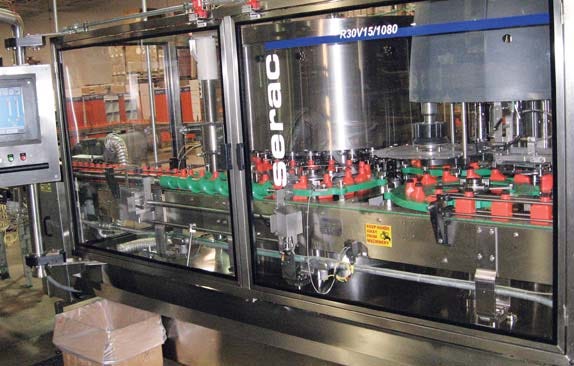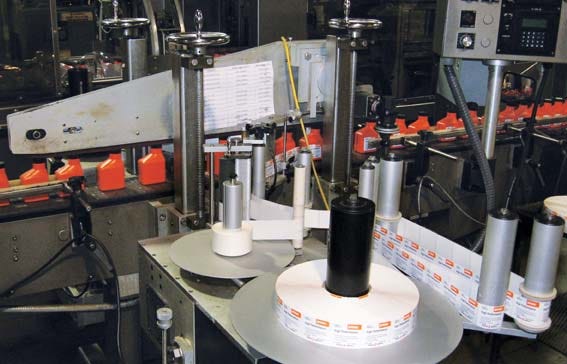Netweight oil filling
|
Monobloc netweight filler/capper with 30 fill valves and 15 capping heads runs bottles ranging in size from 2.6 to 20 oz. |
Established in 2000 and expanded in 2005, Omni Specialty Packaging is a leading supplier of a variety of lubricants, greases and oils for various applications. Its product line comprises more than 100 products, including light and heavy automotive lubricants, industrial and hydraulic lubricants, specialized oils and greases, automotive gear oils, and automatic-transmission fluids and brake fluids. It ships 28 to 30 million gal of packaged oil products a year from motor oil to brake fluid in sizes ranging from 2.6-oz to 1-gal bottles, as well as pails and odd-shaped containers such as measure-top bottles, and bulk totes.
Last year, OSP installed a packaging line, with a Model R30V15/1080 monobloc, net weight, gravity filler/capper from Serac, Inc. (www.serac-group.com) to run a number of its bottles ranging in size from 2.6 to 20 oz. The filler's model number indicates that the unit has 30 fill nozzles and 15 capping heads. “We looked at three or four other fillers,” says maintenance manager Rick McLaurin, “but the Serac is very smart and deadly accurate, and its statistical process software is a real selling point. They've managed to get everything down into a real, condensed form, so everything is modular, dependable and cost-effective. As far as high-end filling machines go, dollar for dollar, Serac is the best deal out there.”
During Packaging Digest's visit, the line was running 270 2.6-oz bottles/min containing two-cycle engine oil for Stihl, Inc., the giant supplier of outdoor power equipment, such as chainsaws and trimmers. These small, rectangular, high-density polyethylene bottles, which are supplied by CKS Packaging, Inc. (www.ckspackaging.com), are asymmetrical with an off-center neck. The bottles are received in paperboard totes and are dumped into a floor hopper of a bottle unscrambler/orienter from Pace Packaging Corp. (www.pacepkg.com). An inclined, cleated conveyor lifts them up to the rotating hopper of the Omni-line M400 unscrambler, which places the bottles in a layflat orientation on a conveyor that carries them past a hook hanging in their path of travel. Bottles, with their bottom ends leading, push the hook up and travel on, but the hook catches the open top of bottles with the top ends leading and flips them over. Thus, all of the bottles have the bottom end leading and they discharge into a standup position on a lower conveyor. The bottles from the unscrambler then enter into a BAO 5000 orienter, where a sensor detects whether the bottles are in neck-leading or a neck-trailing orientation. Photo eyes sense the orientation, and activate a pneumatic-actuated pad to turn the bottles in a neck-trailing orientation so that all of the bottles leave the orienter in a neck-leading orientation.
|
A dual-head, pressure-sensitive labeler applies front and back labels to the 2.6-oz bottles. An overhead holddown belt-assembly maintains control of the bottles during labeling. |
The bottles are then conveyed to the Serac filler. This conveyor makes a long U-shaped loop from the sorter/orienter to the filler to provide accumulation capacity ahead of the filler. A feedscrew at the inlet of the filler meters the bottles into a starwheel that, in turn, places the bottles onto the 30 individual platforms of the filler. Because of the off-center necks of the bottles, the starwheel maintains very precise positioning on the filler platforms to ensure that the open tops are beneath the fill nozzles. To achieve the filler's extreme accuracy, each platform incorporates a loadcell that weighs the bottle as it enters the machine, and then fills product until the weight reaches the set weight of product, at which point the machine stops filling. “When customers premix the oil and gasoline, the oil must be the proper amount for the container size it's mixed in, which allows the engine to perform at peak efficiency,” says McLaurin. “The filler is maintaining 0.1-gram fill accuracy.”
In addition to handling the netweight calculations, the 486 DX2 66 mHz industrial personal-computer-based control system on the filler records processing and filling data for every bottle run and provides statistical production feedback.
For example, it will present a statistical fill-weight average and standard deviation for any period of production selected, monitor the tare weight of incoming bottles and alert the operator if a bottle is outside of the acceptable range, list the number of under-fills and over-fills with the cause of each and monitor run times. When changing from one bottle to another, the operator only has to select the new bottle from the menu in the computer, and the PC will set fill and operating parameters automatically. “Our filler operators love it, because they can change it over in twenty minutes and have it ready to run,” says McLaurin. It's easy to read and easy to go through, because the machine will always tell you what's going on. It makes everyone's job easier.”
After filling, bottles travel through a starwheel into the 15-head capper that is part of the monobloc system. This is followed by an induction sealer from Enercon Industries Corp. (www.enerconind.com). where the foil liners inside the caps are sealed to the tops of the bottles. From the induction sealer, the bottles are conveyed past a Linx 4900 small-character ink-jet printer from Diagraph, an ITW co. (www.diagraph.com) that prints a lot code on the shoulder of the bottle. The bottles are then conveyed past a Model CP2000 pressure-sensitive labeler from Universal Labeling Systems (www.universal1.com) that applies front and back labels.
After labeling, the bottles are conveyed to a Model CFH continuous-motion shrink wrapper from Polypack, Inc. (www.polypack.com) that applies film around groups of bottles. During PD's visit, it was wrapping groups of six of the 2.6-oz bottles. The bottles are divided into two lanes as they approach the wrapper, and a lug conveyor moves the groups of six bottles into the machine. Simultaneously, high-clarity, 3-mil polyethylene film enters the machine from a roll. The film is formed into a tube or sock traveling in the direction of product flow with an overlap on the bottom. Vacuum generated through holes in the conveyor hold the bottom film in place so that it travels with the conveyor. Groups of bottles are pulled along on top of the film as it travels, and a heated blade seals the longitudinal film overlap on the bottom.
A reciprocating forming head containing a heated seal bar travels above each group of bottles, and at the end of the stroke, the blade descends and seals and cuts the film at the trailing edge of one group and the leading edge of the following group. The forming head then moves back and repeats this process for the next group. The wrapped groups of bottles then travel through the shrink tunnel.
The wrapper incorporates a Telemecanique programmable-logic controller from Schneider Electric (www.us.schneider-electric.com) as well as a color touchscreen operator interface with message display and self diagnostics. The unit includes preprogrammed settings for conveyor speeds, timing and temperature settings for fast, accurate setup when changing products.
More information is available: |
Serac, Inc., 630/510-9343. www.serac-group.com. |
CKS Packaging, Inc., 404/691-8900. www.ckspackaging.com. |
Diagraph, an ITW co., 636/300-2000. www.diagraph.com. |
Enercon Industries Corp., 262/255-6070. www.enerconind.com. |
Pace Packaging Corp., 973/227-1040. www.pacepkg.com. |
Polypack, Inc., 727/578-5000. www.polypack.com. |
Schneider Electric, 888/778-2733. www.us.schneider-electric.com. |
Universal Labeling Systems, 722/327-2123. www.universal1.com. |
About the Author(s)
You May Also Like




